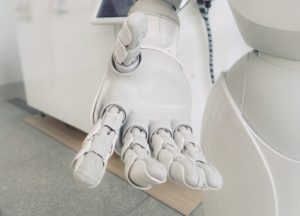 Americans are living longer and in higher numbers than ever before. There are not enough caregivers to meet the needs of this growing elder population. Inventors are developing high-tech solutions to help fill the gap in available people to tend to the needs of aging Americans. Cell phone apps, software, interactive home “smart” devices and robots can help seniors when there are not enough caregivers.
Americans are living longer and in higher numbers than ever before. There are not enough caregivers to meet the needs of this growing elder population. Inventors are developing high-tech solutions to help fill the gap in available people to tend to the needs of aging Americans. Cell phone apps, software, interactive home “smart” devices and robots can help seniors when there are not enough caregivers.
Scientists are making a variety of robotic devices that perform different functions for seniors. For example:
- Researchers in Japan developed a device that looks like a large stuffed animal in the form of a baby seal. Paro, which costs around $6,000, offers emotional support to its users. The device can move its head and legs and make sounds. The developers say Paro can improve a person’s mood and reduce depression and anxiety. The robotic seal responds to light, temperature, sounds and touch.
- AvatarMind is working on elder-focused software for its iPal, a cute little humanoid robot that can sing, dance and tell stories. The device could soon monitor for falls and remind an older adult to take his medicine or go for a walk.
- Mabu is a robot designed to help people with congestive heart failure. The little yellow robot is 15 inches tall and has large eyes that can move back and forth. Mabu tracks the patient’s medication and level of physical activity. The device uses the American Heart Association’s guidelines to assess and interact with the senior. The developers will work on issues like rheumatoid arthritis and late-stage kidney cancer in future generations of the device. Mabu asks questions verbally and on a screen. The robot sends the patient’s responses to his healthcare providers.
- ElliQ does not look humanoid. This small device, still in development, can connect the older adult to other people by text message, video, or photo messaging. ElliQ’s purpose is to provide some companionship for older adults and help them to stay active and engaged. The device can encourage the user to take a walk. ElliQ can ask trivia questions and play music.
The companies that make these “socially-assistive” robots emphasize that the devices can help older Americans stay active, alert and healthy. The developers do not intend for the robots to take the place of humans. The devices can assist with social interaction, not physical interaction. Do not expect robots to help seniors dress, bathe, or receive medical treatment any day soon.
One goal is for the robots to link with technology people already use, like Amazon Echo and smartphones, to monitor the safety of older adults and reach out for help, when needed. Robots could eventually detect when a senior falls or has a medical emergency, like a stroke or heart attack, and call for assistance.
Health insurance usually does not cover the cost to purchase a socially assistive robot, but organizations are contributing to the development of more of these devices. For example, the National Institute on Aging has awarded more than $1 million in research funding. When more options come on the market, the cost will likely come down and become more affordable for consumers.
References:
AARP. “Technology is Transforming Caregiving.” (accessed August 1, 2019) https://www.aarp.org/caregiving/home-care/info-2018/new-wave-of-caregiving-technology.html

